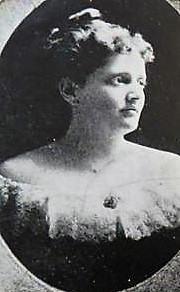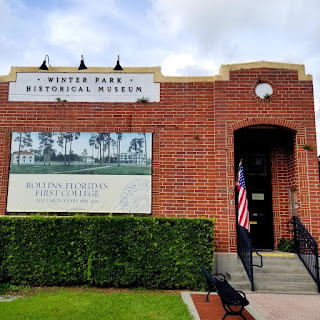Frontierswomen
of Central Florida
A
Women’s History Month Tribute
By
Richard Lee Cronin, CroninBooks.com
5
March 2022
Day 5
CitrusLAND is observing Women’s History Month by
honoring extraordinary Central Florida frontierswomen. And ae celebrate Women’s
History Month throughout March, we are also promoting each day a local History
Museum, listing days and hours of operation.
See
our featured History Museum in this Post
Florence #Clark Milton,
said Pine Castle correspondent Will Wallace Harney of his Orange County
neighbor and fellow Kentuckian, was the driving force in the building of the
first church south of Orlando. The Presbyterian Church service, on lakeshore
property donated by Florence and her husband, William A. Milton, was held
Christmas Day 1876 in the new church building fronting on Lake Jessamine.
Harney described Florence as a “cheery and indefatigable Mrs. Milton, who
afterwards promoted tea party and tableaux which was humorous, satirical, and
sentimental”.
Fund raising for construction of a church had fallen
short of its goal until Florence got involved. She contacted her old church
back at Lexington, Kentucky for assistance, and soon received cash
contributions from Reverend Young of Nicholasville, in Jessamine County,
Kentucky, and others came to the rescue and the church was soon completed.
Florence Clark married William Milton at Henderson, Kentucky in 1869.
[Further
reading; Chapter 20: Lake Jessamine, Beyond Gatlin: A History of South
Orange County, and Orlando Lakes: Homesteaders & Namesakes, both
books by Richard Lee Cronin]
Anna #Cloud Harris
(1854-1932) was raised at Fort Reid, (now Sanford), and yet the best kept
secret about this daughter of one of central Florida’s earliest pioneers, Aaron
Cloud, is that she assisted in financing a luxury hotel which helped put
Tavares on the Florida map. Peninsular Hotel on Lake Dora (photo below) opened
in 1882 with a “Grand Celebration” which drew folks from near and far. Tavares,
at that time part of Orange County, was a dream of Orlando Attorney Alexander
St. Clair-Abrams, a hotel that opened thanks in large part to a $7,000 loan (a
huge sum of money in 1882) from Widow Anna (Cloud) Harris of Fort Reid.
Peninsular Hotel (1882), Tavares
(destroyed by fire in 1888)
A Georgia native, Anna Cloud came to Fort Reid before
the Civil War, at a time when fewer than 1,200 individuals lived in all Orange
County, a landmass that today encompasses Orange, Osceola, Seminole and half of
Lake County. Anna married James T. Harris in 1876, and a son, James Cloud
Harris, was born at Fort Reid in 1878. By 1880, the year her father Aaron died,
Anna also became a Widow.
[Further
reading: Tavares: Darling of Orange County, Birthplace of Lake County, by
Richard Lee Cronin]
Jane #Cornwall (1825-1895)
was the true-life Duchess of Castelluccia of New Smyrna Beach, a fascinating
lady once believed to be Jennie Busch, daughter of Anheuser-Busch fame. But Jane
was not Jennie Busch, rather a woman this author has dubbed, Florida’s
Indian River Duchess. Jane became the inspiration for my ‘Righting
Florida History’ series, and in Volume 1 of this now three volume series, I
document the amazing life of Jane Cornwall, born 1825 in New York State.
The Evening Star
of Washington, DC published an extensive column on 15 March 1882, with the
headline: “Florida has a live duke and
a still liver duchess!” The article explained: “About 30 miles above Rockledge,
on Indian River, is situated the famous Dummett orange grove. The Duke of
Castelluccia, along with his American duchess, purchased the historic
Florida grove for $44,000.” An article in Home Journal of
Winchester, TN, also reported that the land deal of February 9, 1881, was “the celebrated Dummitt orange grove.
Although reporters could
not agree on spelling Dummett versus Dummit, each did concur about the
description of the Indian River parcel, claiming the grove to be “the oldest
and largest grove in East Florida, situated between the Indian River and the
Atlantic, comprising 450 acres, having 3,500 trees now in bearing, producing
last year 4,000 boxes.”
Florida’s Indian River Duchess,
Righting Florida History Series
Reporters were infatuated
with the Duke and Duchess, but they assumed the couple’s wealth had been his. It
was not! Jane married Ercole Tamajo, at Palermo, Italy on January 14, 1873, and
it was that marriage which made the American born bride a Duchess. But her
marriage to the duke had been Jane’s second marriage. She first married Horace
Beals, who had died in 1864.
Jane Cornwall married
Horace Beals at New York City’s Trinity Church when she was only 16. At times a
gambler, Horace became a successful New York businessman after he won an island
off the coast of Maine – an island found to be rich with granite. After his
death in 1864, Jane (Cornwall) Beals continued the business of supplying
granite to building projects in New York, Washington, DC, and elsewhere.
After the Duke of
Castelluccia died in 1893, Jane, a Widow for the second time, still a resident
of New York City at age 68, was not quite ready to fade from inquisitive
reporters. Although she had died in 1895 at the age of 70, mention of her name
appeared again in newspapers across the country.
Jane’s renewed coverage in
the 20th century began with a 1902 arrest of Edward Leonard Dwyer for
drunkenness. In the February 7, 1902, article, Dwyer
disclosed that his “meteoric career” had
begun in Chicago in 1886 while a member of the board of trade, by buying a
million bushels of wheat”. Dwyer was at that time only 21 years of age.
The article went on to say
that in 1894, Dwyer met the “Duchess de Castelluccia.” Our Duchess, then 70
years old, married Dwyer, then 30 years old, at Rockledge, Florida. Richard
Croker, ex-leader of New York’s Tammany Hall, had been Dwyer’s best man. (A New
York City “Boss”, an 1893 Harper’s Weekly Editorial compared Richard Croker to
“17th Century Stuart kings who tried to rule England as absolute
monarchs.”
Quite a colorful figure,
the notoriety of Jane (Cromwall) Beals – Tamajo – Dwyer exposed the early history
of central Florida’s Dummett Grove, which in turn revealed how Florida’s Citrus-
Belt emerged during the 1880s. A ‘Royal’ couple indeed, they became a colorful
addition to the Indian River community during the 1880s, with the Duchess
returning to Florida at age 69 in 1894 to marry a third time – to a young man
30 years of age.
[Further reading: The whole story, including a detailed bibliography,
will be found in Florida’s Indian River Duchess by
Richard Lee Cronin]
Miss Hattie #Daggett (1866-1951) made a name for herself in lake
County long before making a name for herself once again as Mrs. Millholland. In
fact, Clermont would not be the same today had this lady from New Jersey not
come to Florida in search of winter home for her aging parent’s. In 1888. Miss
Daggett arrived at Lake Minneola aboard the Orange Belt Railway. The town was
still very much in its earliest stages of development, but after personally inspecting
land to the south of town, Hattie purchased twenty (20) acres from the Florida
Land and Colonization Company, closing on her land purchase in June 1889.
Hattie, like the out-of-state company developing the city
of Clermont, was a native of Vineland, New Jersey, so upon her arrival, Hattie looked
to former New Jersey neighbor William House to help locate a perfect homesite. Among
potential locations House showed Hattie was land where he had wanted to locate the
town of Clermont. He was outnumbered by those desiring to locate on Lake
Minneola, and so not only did Miss Daggett acquire twenty acres where House desired
to establish Clermont, she also founded the Monte Vista Land & Development
Company, which Hattie managed for several decades.
Clermont, Gem of the Hills,
by Miriam W. Johnson and Rosemary Y. Young (1984), gives an excellent account
of Miss Daggett’s Monte Vista community; of the first cabin she had built a
year after arriving in Florida, and of a later historic Log House Hattie
constructed in 1896.
Miss Hattie Daggett (1896)
Courtesy Clermont Historical Society
Log House Road today leads to the vicinity of Hattie’s
one-time Log House, built atop a ridge overlooking Lake Minnehaha, where Hattie
enjoyed entertaining. Eustis citizens, reported the Eustis Daily Region
newspaper of April 17, 1926, “motored to the Log House at South Clermont, where
over three hundred people thronged the house and grounds to hear Edward Brigham,
famous basso-profundo and dramatic reader of Steinway Hall, New York.”
By 1926, Hattie had married. “Mr. Brigham was secured
for the event,” reported the Eustis Lake Region,” through the efforts of Mrs.
Hattie D. Millholland and the concert, under the auspices of the Clermont Music
Club, pleased and delighted the audience.
Hattie H. (Daggett) Millholland (1947)
Hattie Hayden Daggett married Robert Douglas
Millholland of nearby Oakland on April 6, 1901, and the newlyweds settled at Hattie’s
historic Log House in South Clermont. Beginning March 3, 1915, Robert served as
Postmaster of South Clermont until his death in 1926, after which “Mrs. Hattie
D. Millholland became postmaster.
Among Hattie’s accomplishments as a developer was the dredging
of a canal to help the Monte Vista farmers get their produce to market. Clermont,
Gem of the Hills, details her involvement: ‘They called on Hattie for help.
She had the land surveyed and grade stakes set, recruited labor at Sanford,
camped them on the ground and personally superintended the cutting of a canal 15
feet wide at the bottom and 30 feet wide on the top. This was the start of the
Monte Vista Canal which connects Crescent Lake and Lake Minnehaha.”
Mount Dora Topic
newspaper of May 6, 1926, reported that “Wise Boat Works of Mt. Dora” had
received a $2,000 contract to rebuild the Hattie M, by Mrs. Hattie D.
Millholland.” The vessel was to include installation of “one of the best marine
motors manufactured.”
[Further reading: Clermont, Gem of the Hills, by Miriam W. Johnson and Rosemary Y. Young (1984)]
Our History Museum of the Day
Winter Park History Museum
200
West New England Avenue, Winter Park, Florida
407-647-2330
Tuesday
thru Friday, 10 AM to 4 PM, Saturday, 9 AM to 2 PM
Questions?
Email Rick@CroninBooks.com







No comments:
Post a Comment